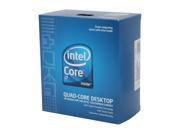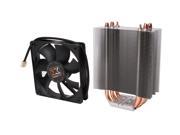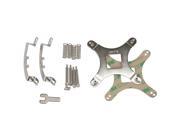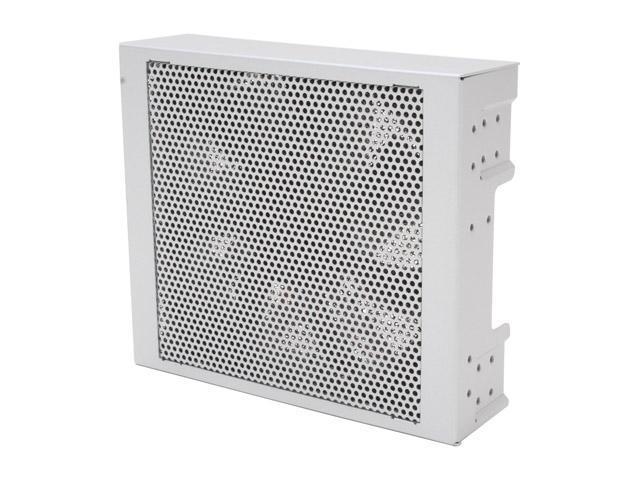JakFrost
Limp Gawd
- Joined
- Dec 2, 2005
- Messages
- 241
I've been reading a lot of overclocking threads and it seems that folks mostly use water based setups and I'm having a hard time finding accurate and reliable info for air overclocking. I'm asking for any info from folks that did overclocking on air or have read other threads where they saw other people do that also.
I've just started trying to overclock my system and I can get to 3.6 GHz (180 x 20) at CPU: 1.25 V at 85C with RealTemp while doing a Prime95 stress test SmallFFT or LargeFFT. I think that I can push this CPU down to 1.75 V or 1.15 V and maintain stability at 3.6 GHz and lower my load temps to ~77C if I spend a little more time.
However, I'm looking to do 3.8 GHz on air with reasonable temperatures ~80C on load so I need some advice.
Processor Information
Processor: Intel Core i7 920 2.66 GHz
Revision: D0 (SLBEJ)
FPO/Batch#: 3901A238
Date of purchase: 2009-06-29
Place of Purchase: Newegg.com
Articles
X-Bit Labs - Intel Core i7-920 Overclocking Guide
Extreme Tech - Overclocking Core i7 920 on the ASUS P6T Deluxe
The Parts
Below are the parts that I picked out. I used all of them before and they all worked together well.
Processor: Intel Core i7 920 Nehalem 2.66GHz 4 x 256KB L2 Cache 8MB L3 Cache LGA 1366 130W Quad-Core Processor - Retail - $279.99 - D0 (SLBEJ) - Batch# 3901A238

Motherboard: ASUS P6T LGA 1366 Intel X58 ATX Intel Motherboard - Retail - $249.99 - 0603 Firmware

Memory: G.SKILL 6GB (3 x 2GB) 240-Pin DDR3 SDRAM DDR3 1600 (PC3 12800) Triple Channel Kit Desktop Memory Model F3-12800CL8TU-6GBPI - Retail - $99.99

Heatsink: XIGMATEK HDT-S1284EE 120mm Rifle CPU Cooler - Retail - $39.99

Bracket: XIGMATEK ACK-I7363 CPU Cooler - Retail - $9.99

FrostyTech - Xigmatek HDT-S1284EE Heatsink Review
[size=-2]
MOB: ASUS P6T, LGA 1366, Intel X58 ICH10R, 3 SLI, 6 DIMM, 6 SATA - FW: 0603, AiTweaker XMP, Turbo Off, HT On, SpeedStep On, C-Step On, (All) Auto
CPU: Intel Core i7 920, 2.66 GHz, 4C, 8 MB, 4.80 GT/s QPI, 45nm, 130 W, D0 (SLBEJ) 3901A238 - 3.60 GHz, BCLK 180, Multi 20, CPU 1.20 V (Manual), QPI 1.21250 (Auto)
FAN: Xigmatek HDT-1284EE 120mm Hydro Bearing Fan 800-1500 RPM 4 Heatpipes - 41 C Idle, 81 C Load
RAM: G.Skill 6gb (3 x 2 GB) DDR3 1600 (PC3 12800) 8-8-8-21 2T 1.60 V - XMP Profile 1, Ratio 2:8, Frequency 720 MHz (1,440 MHz), DRAM 1.60 V
VID: eVGA nVidia GTX 260 896 MB G92 192c 576/999 MHz PCI-e 2.0 16x 2xDVI 1xSVid 1xHDTV - 600/1100 MHz, DVI to LCD, HDMI 60' to 50" Plasma TV.
CAP: AverMedia AVerTV Combo PCI-e M780R ATSC/NTSC Capture MPEG-2 Hardware Encoder - MCE Remote, IR Receiver
CAS: Lian-Li PC-V1200 Plus Mid-ATX Aluminum 4x5.25 6x3.5 2x120mm - Best case to date in my opinion.
POW: OCZ PowerStream 520W SLI ADJ ATX2.0 EPS12, +3.3V 28A +5V 40A +12V 33A
SSD: Intel X25-M 80GB MLC SSD SATA II 3 GB/s - FW: 8820
HDD: Western Digital Caviar SE16 500 GB WD5000AAKS 16 MB SATA-II - (4) in (2) RAID-1 (Mirror) Arrays
ENC: MacAlly G-S350SU External HDD Enclosure 3.5" eSATA USB 2.0 Aluminum, Universal 12V Adapter - (2) external WD GP 1TB for Movies
ENC: i-Rocks 9410 External HDD Enclosure 3.5" eSATA USB 2.0 Aluminum, Univeral 12V Adapter - (2) external WD GP 1TB for Backups
HDD: Western Digital Caviar GP Green 1 TB WD10EACS 16 MB SATA-II - (2) external Movies, (2) external for Backups
CON: JMicron JMB363 PATA and SATA Controller, PCIe 1x, 1 PATA, 1 SATA, NCQ, Hotplug, RAID 0,1,0+1,JBOD
CON: JMicron JMB322 SATA II 3 GB/s Controller, PCIe 1x, 2 SATA, NCQ, Hotplug, RAID 0,1,JBOD
NIC: Realtek 8111C PCIe GigE
SOU: Realtek ALC1200 8 channel, HD Audio, Coax/Opt S/PDIF - Analog for Speakers, Motherboard Digital S/PDIF to nVidia GTX 260 S/PDIF for DVI->HDMI
DVD: NEC ND-3550A 16x DVD+-RW SL/DL 48X CDR PATA - FW: 1.07
BLU: LG GGW-H20L Blu-ray 6x BD-RE 16x DVD SL/DL 48x CDR SATA - FW: YL05
MON: HP LP2475w 24-inch LCD H-IPS Monitor Wide Gamut 102% NTSC 6-12ms Response - 1920x1200x32 60Hz, DVI, GIG122/GIG052, Bri 15, Con 80, 9300K
KBD: Microsoft Natural Keyboard Pro USB/PS2 Media Keys
MOU: Microsoft IntelliMouse Explorer 3.0 Optical USB/PS2 Scroll-Wheel 5-Button
JOY: CH Products Fighterstick USB 3 axes 24 buttons
THR: CH Products Pro Throttle USB 3 axes 24 buttons
PED: CH Products Pro Pedals USB 3 axes
ROU: Linksys BEFSR81 EtherFast Cable/DSL Router 8-port Switch 100MBps FW: 2.51.3
OSS: Microsoft Windows 7 Release Candidate Build 7100
[/size]
I've just started trying to overclock my system and I can get to 3.6 GHz (180 x 20) at CPU: 1.25 V at 85C with RealTemp while doing a Prime95 stress test SmallFFT or LargeFFT. I think that I can push this CPU down to 1.75 V or 1.15 V and maintain stability at 3.6 GHz and lower my load temps to ~77C if I spend a little more time.
However, I'm looking to do 3.8 GHz on air with reasonable temperatures ~80C on load so I need some advice.
Processor Information
Processor: Intel Core i7 920 2.66 GHz
Revision: D0 (SLBEJ)
FPO/Batch#: 3901A238
Date of purchase: 2009-06-29
Place of Purchase: Newegg.com
Articles
X-Bit Labs - Intel Core i7-920 Overclocking Guide
Extreme Tech - Overclocking Core i7 920 on the ASUS P6T Deluxe
The Parts
Below are the parts that I picked out. I used all of them before and they all worked together well.
Processor: Intel Core i7 920 Nehalem 2.66GHz 4 x 256KB L2 Cache 8MB L3 Cache LGA 1366 130W Quad-Core Processor - Retail - $279.99 - D0 (SLBEJ) - Batch# 3901A238

Motherboard: ASUS P6T LGA 1366 Intel X58 ATX Intel Motherboard - Retail - $249.99 - 0603 Firmware

Memory: G.SKILL 6GB (3 x 2GB) 240-Pin DDR3 SDRAM DDR3 1600 (PC3 12800) Triple Channel Kit Desktop Memory Model F3-12800CL8TU-6GBPI - Retail - $99.99

Heatsink: XIGMATEK HDT-S1284EE 120mm Rifle CPU Cooler - Retail - $39.99

Bracket: XIGMATEK ACK-I7363 CPU Cooler - Retail - $9.99

FrostyTech - Xigmatek HDT-S1284EE Heatsink Review
[size=-2]
MOB: ASUS P6T, LGA 1366, Intel X58 ICH10R, 3 SLI, 6 DIMM, 6 SATA - FW: 0603, AiTweaker XMP, Turbo Off, HT On, SpeedStep On, C-Step On, (All) Auto
CPU: Intel Core i7 920, 2.66 GHz, 4C, 8 MB, 4.80 GT/s QPI, 45nm, 130 W, D0 (SLBEJ) 3901A238 - 3.60 GHz, BCLK 180, Multi 20, CPU 1.20 V (Manual), QPI 1.21250 (Auto)
FAN: Xigmatek HDT-1284EE 120mm Hydro Bearing Fan 800-1500 RPM 4 Heatpipes - 41 C Idle, 81 C Load
RAM: G.Skill 6gb (3 x 2 GB) DDR3 1600 (PC3 12800) 8-8-8-21 2T 1.60 V - XMP Profile 1, Ratio 2:8, Frequency 720 MHz (1,440 MHz), DRAM 1.60 V
VID: eVGA nVidia GTX 260 896 MB G92 192c 576/999 MHz PCI-e 2.0 16x 2xDVI 1xSVid 1xHDTV - 600/1100 MHz, DVI to LCD, HDMI 60' to 50" Plasma TV.
CAP: AverMedia AVerTV Combo PCI-e M780R ATSC/NTSC Capture MPEG-2 Hardware Encoder - MCE Remote, IR Receiver
CAS: Lian-Li PC-V1200 Plus Mid-ATX Aluminum 4x5.25 6x3.5 2x120mm - Best case to date in my opinion.
POW: OCZ PowerStream 520W SLI ADJ ATX2.0 EPS12, +3.3V 28A +5V 40A +12V 33A
SSD: Intel X25-M 80GB MLC SSD SATA II 3 GB/s - FW: 8820
HDD: Western Digital Caviar SE16 500 GB WD5000AAKS 16 MB SATA-II - (4) in (2) RAID-1 (Mirror) Arrays
ENC: MacAlly G-S350SU External HDD Enclosure 3.5" eSATA USB 2.0 Aluminum, Universal 12V Adapter - (2) external WD GP 1TB for Movies
ENC: i-Rocks 9410 External HDD Enclosure 3.5" eSATA USB 2.0 Aluminum, Univeral 12V Adapter - (2) external WD GP 1TB for Backups
HDD: Western Digital Caviar GP Green 1 TB WD10EACS 16 MB SATA-II - (2) external Movies, (2) external for Backups
CON: JMicron JMB363 PATA and SATA Controller, PCIe 1x, 1 PATA, 1 SATA, NCQ, Hotplug, RAID 0,1,0+1,JBOD
CON: JMicron JMB322 SATA II 3 GB/s Controller, PCIe 1x, 2 SATA, NCQ, Hotplug, RAID 0,1,JBOD
NIC: Realtek 8111C PCIe GigE
SOU: Realtek ALC1200 8 channel, HD Audio, Coax/Opt S/PDIF - Analog for Speakers, Motherboard Digital S/PDIF to nVidia GTX 260 S/PDIF for DVI->HDMI
DVD: NEC ND-3550A 16x DVD+-RW SL/DL 48X CDR PATA - FW: 1.07
BLU: LG GGW-H20L Blu-ray 6x BD-RE 16x DVD SL/DL 48x CDR SATA - FW: YL05
MON: HP LP2475w 24-inch LCD H-IPS Monitor Wide Gamut 102% NTSC 6-12ms Response - 1920x1200x32 60Hz, DVI, GIG122/GIG052, Bri 15, Con 80, 9300K
KBD: Microsoft Natural Keyboard Pro USB/PS2 Media Keys
MOU: Microsoft IntelliMouse Explorer 3.0 Optical USB/PS2 Scroll-Wheel 5-Button
JOY: CH Products Fighterstick USB 3 axes 24 buttons
THR: CH Products Pro Throttle USB 3 axes 24 buttons
PED: CH Products Pro Pedals USB 3 axes
ROU: Linksys BEFSR81 EtherFast Cable/DSL Router 8-port Switch 100MBps FW: 2.51.3
OSS: Microsoft Windows 7 Release Candidate Build 7100
[/size]
Last edited:
As an Amazon Associate, HardForum may earn from qualifying purchases.
![[H]ard|Forum](/styles/hardforum/xenforo/logo_dark.png)
















